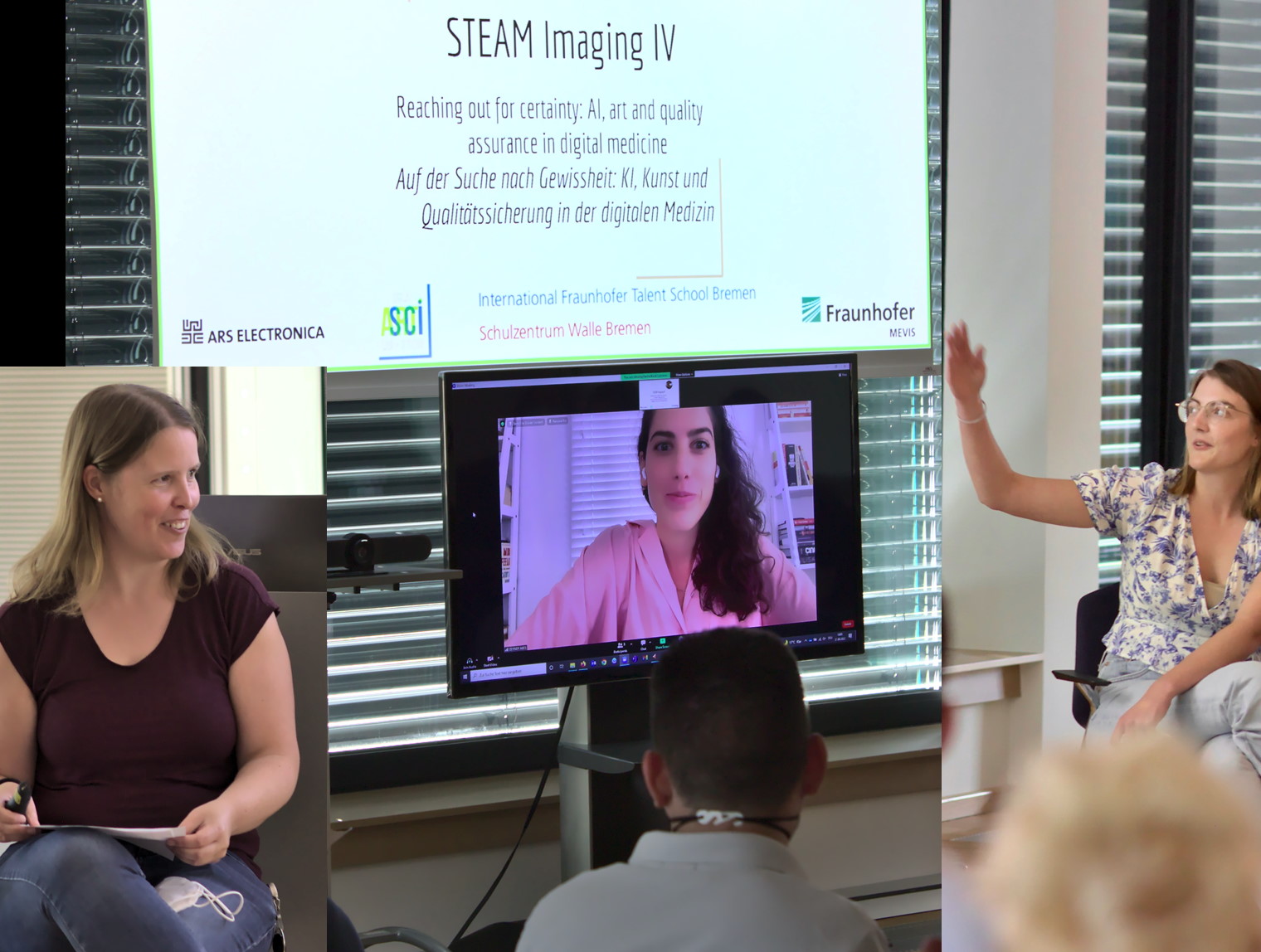Institutsmitteilung
Fraunhofer MEVIS is delighted to complete ”STEAM Imaging IV“ with the independent evaluation of the workshops with school students and STEAM evenings with their parents as part of the artist-in-residence program STEAM Imaging IV. The Program allows media artists to engage in intensive exchange with Fraunhofer MEVIS scientists to critically examine current methods, developments, and research results in their works. A key component of the program is the shared encounter with school students and, in STEAM Imaging IV, their parents from the School Center Walle, Bremen. The art and research alliance enabled prospective university students and their parents to approach scientific and technical topics from a new and unexpected perspective and encouraged them to engage with science, technology, and art in a self-determined, creative way. »STEAM Imaging IV« was hosted by Fraunhofer MEVIS, Bremen, Germany, in collaboration with Ars Electronica, Linz, Austria, the International Fraunhofer Talent School Bremen, the School Center Walle, Bremen, and the UCLA ArtSci Center, Los Angeles, USA.
A vital part of the residency program is the joint activities with students from the health focus at the School Center Walle. In the workshop series entitled “From the hand to the magnetic resonance tomograph to the smartphone: Manually and digitally generated representations of the body” they gained hands-on experience in medical image processing, anatomical-medical drawing, and AR technologies. They also met Abes, who began her collaboration with MEVIS during the same period. Alongside the scientists, they developed topics for three themed evening events „Many Ways into Medicine and Research“ on current health topics: How does memory change in Alzheimer’s disease? What is still science fiction, and what is already a reality in medicine? How does medical research find its way into the clinical routine? What has made these evenings even more special has been inviting the pupils’ parents. By doing so, the researcher want to provide access to new technologies in digital medicine and STEM subjects required for this. Bringing education closer to the demands of the real world and the need to attract young STEM academics with diverse life backgrounds are important challenges that are addressed with the project. Parents are still one of a child’s main influences when it comes to choosing a field of study. Prepared core questions from the heart of the evening event. They serve as a framework for dialogue between Zeynep Abes and the MEVIS researchers, open to all participants.
The evaluated was done by Dr. Claudia Schnugg, a curator and producer of art and science collaboration and a researcher in the intersections of art and aesthetics with science, technology, and business. The results are available upon request. The range of activities is perceived as an exciting and incredible opportunity by the participants. They value the opportunity to work with the scientists and get insights into the professional life at a scientific organization. The introduction to digital medicine opens a new field of knowledge and interdisciplinary connections for the high school students which most of them did not know of before. Specifically, seeing and learning about the technologies used in medical applications was eye-opening for many of them. The students also reported that they used this opportunity to reflect on their career options and learn about the daily work of professional scientists developing technologies for digital medicine. The various methods applied and disciplines experienced to tackle digital medicine created entry points for students with different abilities and interests to access the topic. As reported by the teacher, it was observed that high school students were inspired to bring an interdisciplinary approach into practice when they do have the opportunity, such as in project work. The three themed evenings are a valuable addition to the workshops for the high school students to get an in-depth insight into specific themes and cases in digital medicine and to convey their insights to their families and friends. It is important for the students to do so on a personal level, especially in cases of highly motivated and inspired students. Also, the external view from a teacher’s perspective supports this impression. Moreover, the connection between scientists and art has been stated as essential to support the core goals and the credibility of the program.
 Fraunhofer-Institut für Digitale Medizin MEVIS
Fraunhofer-Institut für Digitale Medizin MEVIS